Last Updated on April 13, 2022 by
We are too busy in our lives to notice the currency that we use every day. The new notes post demonetisation is not so new anymore. But have you noticed the monuments on the new notes? If not, do it now because my post is all about the monument on 100 Rupee Note called Rani-ki-Vav. This blog covers the what and where is rani-ki-vav and also about its breathtaking architecture.
So let’s dive straight into Rani-ki-Vav Details, History, Architecture and why is it so important to India?
Table of Contents
What is Rani-ki-Vav?
Rani-ki-Vav literally translates to ‘Queen’s Stepwell’. ‘Vav’ in Gujarati is a stepwell. Stepwells are one of the water conservation methods that were used traditionally in India. The stepwells were designed to store water for drinking purposes as well as for other utilities. Stepwells are found in most states of India clearly showing their utility in the yesteryears. Due to its design, the water at the end of the storey remained cool and gave a much-needed respite to the locals. Stepwells are called Baoli in Delhi (Read: Agrasen ki Baoli) and Kund in Rajasthan (Read: Panna Meena ka Kund, Jaipur).
Stepwells were constructed either in circular or rectangular shapes and were multi-storeyed. The Rani-ki-Vav structure is rectangular and is seven storeys deep while the well is circular in shape. Steps that lead to the water stored underground are intricately carved.
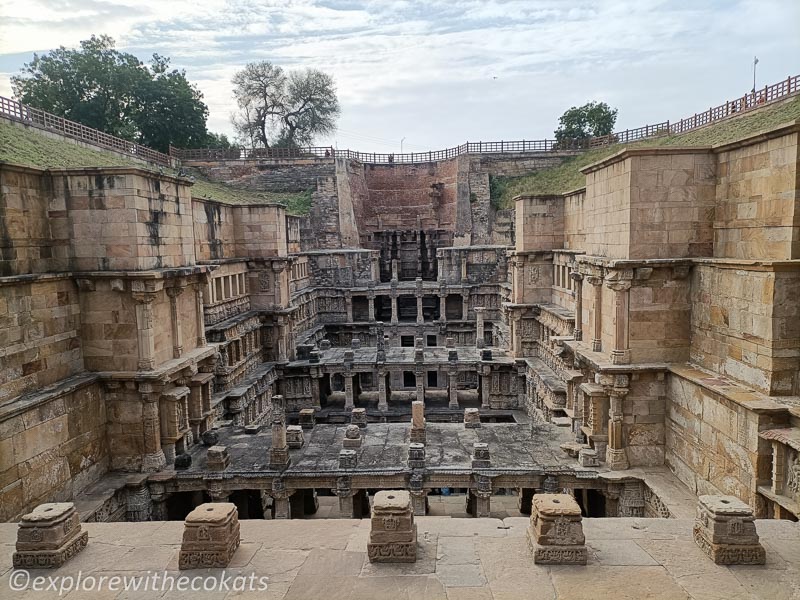
Where is Rani-ki-Vav?
After Patan Patola, the next best thing in Patan is Rani-ki-Vav. Or is it the other way around? Rani-ki-Vav is situated in the town of Patan in Gujarat. It is located on the banks of the Saraswati river.
History of Rani ki vav stepwell
Rani-ki-Vav is an 11th-century stepwell located on the banks of the Saraswati River. According to a Jain chronicle, it was built by a queen which is how the stepwell got the name. Queen Udayamati built the stepwell in memory of her husband Bhima I (1020-1064) but it was possibly completed by another Chalukya king.
The stepwell was a major landmark for the area that provided water to thousands. It was not only a hydrological project as well as a religious structure. It was designed as an inverted temple respecting the sanctity of water which was scarce in those times.
The stepwell was buried till the 1980s, due to excessive flooding of the river Saraswati. After excavation, archaeologists found the intricate carvings which it was added to the list of UNESCO World Heritage Sites.
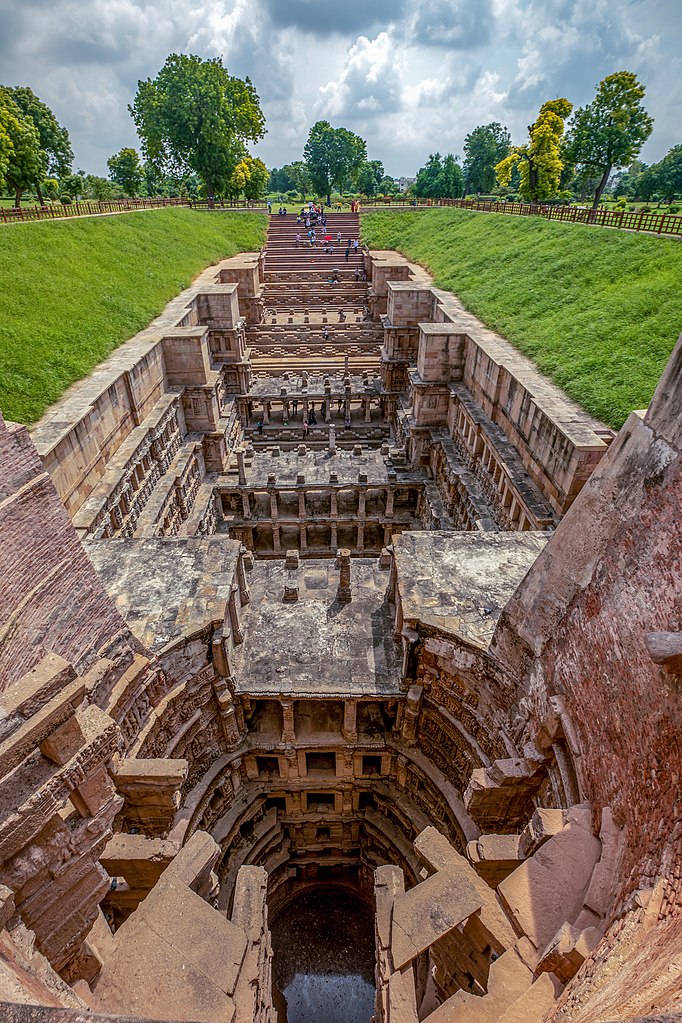
Why is Rani-ki-Vav on 100 Rupees Currency Note?
Throughout history, Indian currency notes have been popular and widely acclaimed for their magnificent architectural images. The Reserve Bank of India (RBI) decided to print Historical Monuments on Indian currency to display the cultural diversity and achievements of the country.
Rani-ki-Vav was chosen to be featured on the 100 Rupees Currency Note.
I have been to Konark Sun Temple which features on 10 Rupee Note and Red Fort Delhi which features on 500 Rupee Note.
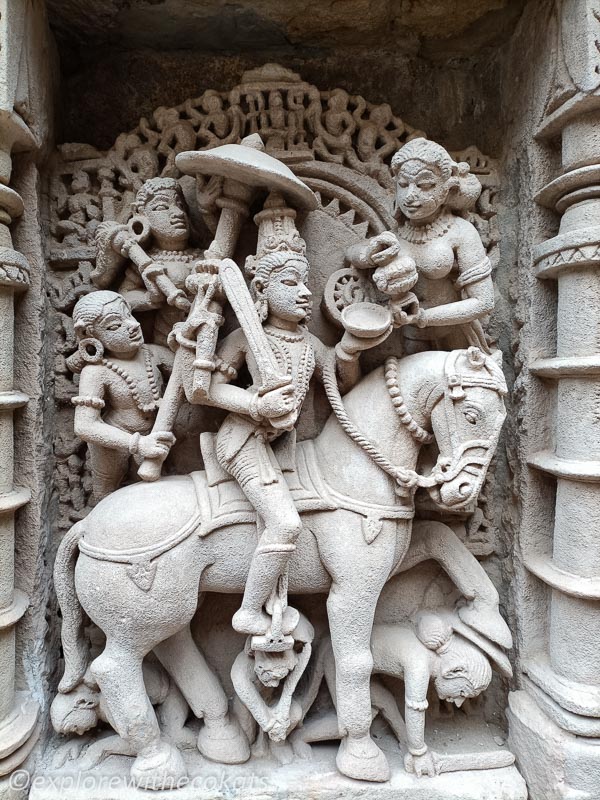
Rani-ki-Vav Architecture
Rani-ki-Vav is known to have been built by men of the Chalukyan dynasty in the Maru-Gurjara architectural style. The stepwell is classified as a Nanda-style stepwell, a style that originated in the medieval ages. The carvings demonstrate mastery of this complex technique and great beauty of detail and proportions.
This stepwell is 213 feet (65m) wide, 66 feet (20m) long and 100 feet deep (28m). A gateway to the stepwell is accessed by a flight of stairs. The seven levels of stairs lead to a deep circular well. There are stepped corridors at every level with pavilions. More than 200 pillars grace the structure and the walls, as well as the pillars, are adorned with carvings and inscriptions.
The Sculptures of Rani-ki-vav | An exhibition gallery chiselled in stone
There are over 3000 plates of sculptures all over the walls, steps and pillars and over 1500 religious and mythological sculptures and secular nature in various sizes, the site is highly decorated.
Apsaras, Yoginis and Nagkanyas
There are also sculptures of women in the form of Apsaras, Yoginis and Nagkanyas seen in a variety of poses, mostly displaying them in a domestic setting. The young women are portrayed in a variety of attitudes—bearing objects of worship such as lamps, conch shells, bells, garlands, or fly-whisks; adorning themselves with earrings or anklets; gazing into a mirror; dancing, sporting with balls; reacting to mischievous monkeys, and so on.
Even more striking are the sculptures of the ‘serpent maidens’ or Nagkanyas. These figures carry cranial cups overflowing with fish and snakes and have cobras coiled around their limbs. Some of the sculptures depict owls perched on an overhanging ledge while others have peacocks, considered as being the natural enemies of snakes.
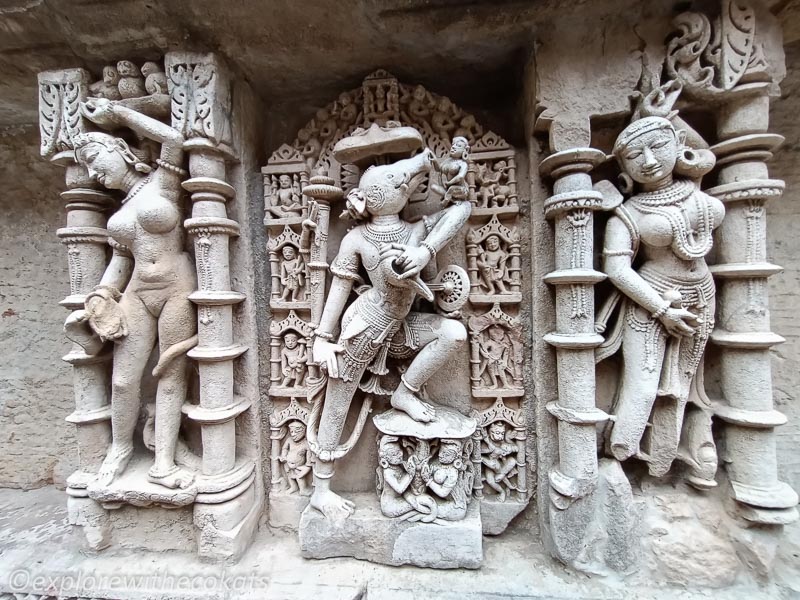
Patola Saree Design Inspiration
Some motifs on the walls have been adapted as designs on the beautiful hand-woven Patola saris since the 11th century in Patan. It is said that more than 700 Patola weaver families were invited from Jalna in Maharashtra to settle in Salvivad near Patan by King Siddharaja. The fine silk and the double ikat weave of Patola were prized by the royalty as ceremonial and holy cloth. Today, hardly three-four families carry on the traditional handloom weaving of Patola, and one of the Salvi families has built a Patola House in Patan as a museum-cum-weaving centre.
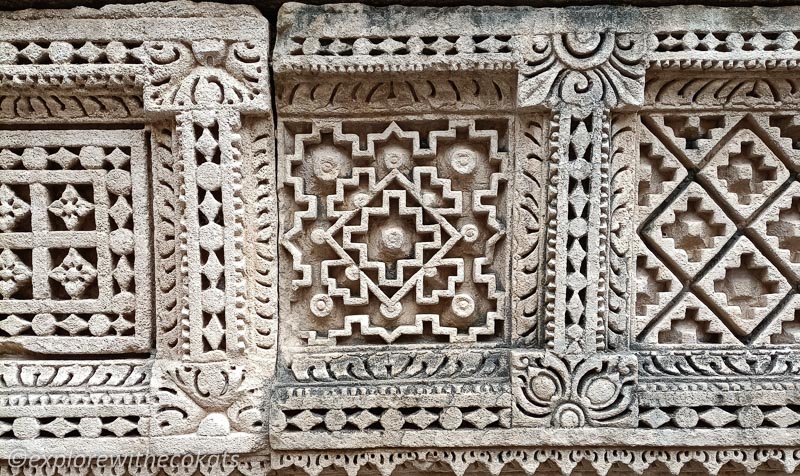
Lord Vishnu avatars in Rani-ki-Vav
The sculptures at Rani-ki-Vav are in devotion to Lord Vishnu, in the forms of Dashavatara (10 avatars) that are Kalki, Rama, Mahisasurmardini, Narsinh, Vaman, Varaha and others representing their return to the world. I have seen similar sculptures in Badami cave temples and Aihole temple town.
At water level, Lord Vishnu manifests himself as Sheshashayi, reclining on a thousand-hooded serpent and his famous reclining pose, sleeping after having provided for the world.
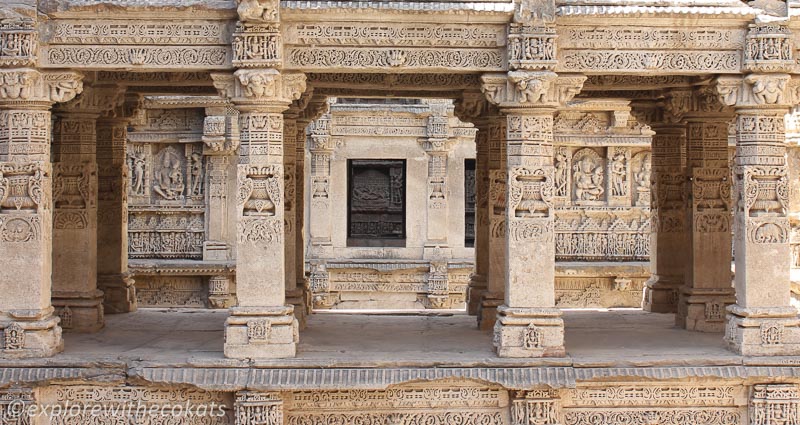
My visit to Rani-ki-Vav Patan
I thought I might not be in as much awe as on my first visit to Rani-ki-Vav. But I was wrong.
After scanning the QR code on my entry ticket I walked on a pathway that was surrounded by manicured gardens. The pathway opened up to the grand stepwell.
Of the many stepwells in Gujarat, this is one of the most finely kept and preserved Vavs in Gujarat. As I climbed a few steps down I can see the steps leading to the reservoir down. I couldn’t help but notice that the Rani-ki-Vav is divided into seven levels of stairs which lead down to a deep circular well. A stepped corridor is compartmentalized at regular intervals with pillared multistory pavilions. The walls, pillars, columns, brackets and beams are ornamented with carvings and scrollwork. The niches in the side walls are ornamented with beautiful and delicate figures and sculptures. There are 212 pillars in the stepwell.
I spent the next one house ogling at the sculptures and photographing them.
Rani-ki-Vav timing
The stepwell is open every day, including Sundays, from 8 am to 6 pm.
Rani-ki-Vav entry fee
INR 40 for Indian Nationals and INR 600 for Foreign Nationals. Photography is included in this fee but tripods and drones are not allowed. Prior permission needs to be obtained for drone shooting.
Best time to visit Rani-ki-Vav stepwell
Mornings and evenings are the best time to visit the stepwell as the weather is very pleasant.
Month wise, Gujarat is extremely hot during summers with temperatures rising up to 45 degrees. Monsoon is humid making it better than summer but still uncomfortable to walk. Winters are the best season to visit Gujarat.
Where is Rani-ki-Vav and How to reach
By road
Rani-ki-Vav is located in Patan and is a popular one day trip from Ahmedabad. Patan is 127 km away and can easily be combined with Modhera Sun Temple and Vadnagar. Gujarat State Road Transport Corporation (GSRTC) buses ply between Patan and Ahmedabad and other major cities of Gujarat regularly. From the Patan Bus stand, Rani-ki-Vav is only 4 km and one can easily get an auto-rickshaw to reach it.
Visitors can hire one-day private taxi from Ahmedabad to cover Modhera and Patan in one day.
By train
The nearest railway station to Patan is Mehsana. However, the connectivity is not great in major cities of India. So one can take a train to Ahmedabad and then a bus or taxi to Patan.
By flight
The nearest airport to Rani-ki-Vav is Ahmedabad airport at a distance of 123 km. You can take a bus or a cab from the airport to reach the stepwell.
Hotels near Rani-ki-Vav, Patan
Since most people prefer a one day trip from Ahmedabad, the accommodation options in Patan are fewer. There are a few mid-range hotels in case you want to extend your stay.
Other places to visit in Patan
Temples of Patan
Patan was an important site for the Jain community during the Solanki rule (950-1300 CE), who built several beautiful temples in the area. The largest group of temples, comprising over 100 structures, is the Panchasara Parshvanath Jain Derasar, which is distinguished by its typical architecture of white marble floors and fine stone carvings. Among them, the Kapur Mehta Na Pado is known for its beautiful wooden interiors and Mahavir Swami Derasar in Dhandherwad is one of the most prominent ones.
Sahastraling Talav
Also known as Durlabh Sarovar, this man-made reservoir was built on the Durlabh Sarovar to transfer water from the Saraswati river. Constructed in medieval times, engineering is commendable as it is among the biggest waterfront constructions made during those times. The reservoir looks like a work of art as intricate carvings of deities grace its walls and columns. The monument is protected by the Archaeological Survey of India (ASI).
Patan Patola Heritage Museum
While visiting Patan it is only fair to witness the making of a Patola saree. Making of Patola involves a very intricate and complex warp and weft weaving. Patola weaving requires a lot of skill, precise mental calculations, vibrant imagination, patience, undivided attention, and agility of the hand. Because of the skill required, only a couple of families practice this traditional art in Patan. The Patan Patola Heritage Museum is a must-visit for Patola silk weaving in action.
The Patola weave is exclusively done on silk with double ikat weaving. Vegetable dyes are used to add colour to the fabric. Sarees and stoles are made from the weave and they cost anywhere between INR 20,000 and INR 20,00,000, depending on the intricacy of the work.
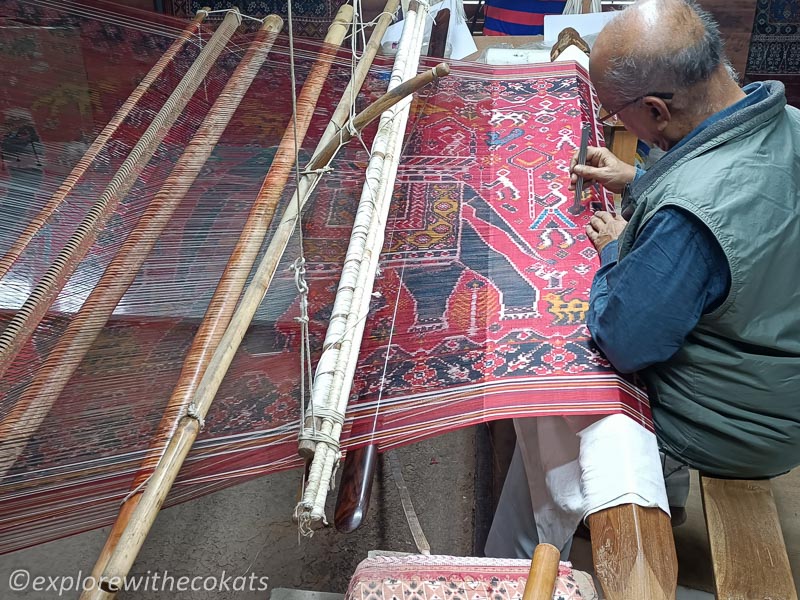
Sustainable tips for the visit to Rann Vav
- Being an ancient stepwell, respect the structures by not defacing them.
- Do not harm the structures by carving or writing on it.
- Do not dispose of garbage in the stepwell premises or in the water well.
- Wear comfortable shoes and dress modestly.
I hope the readers now know where is Rani-ki-Vav and its importance on the 100 Rupee Currency Note.
Read about other Vavs in Gujarat
Read about other posts in Gujarat
- Statue of Unity Guide- Day trip from Ahmedabad
- Bhuj – Gateway to Rann Utsav
- Rann Utsav at Tent City
- Places to visit in Jamnagar
- Things to do in Vadodara
- Girnar Ropeway
Disclaimer – This post contains affiliate links. It means it adds no extra cost to you if you book through the link but I get a referral bonus which helps me earn a little to keep this website up and running.
Pin this post!
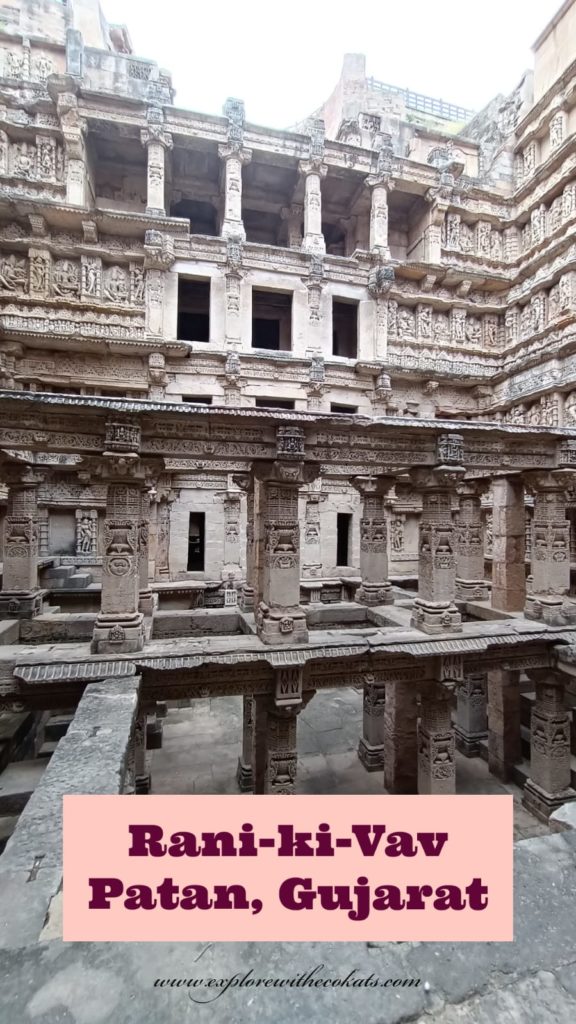

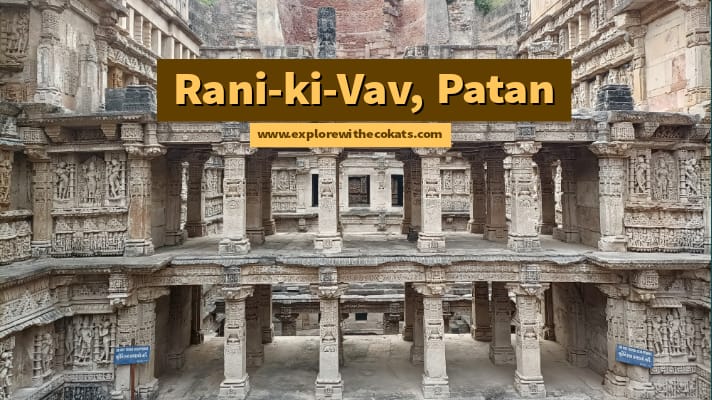
6 comments
U R very good at presenting and explaining all major details and the related info.I am impressed. Please keep it up. Regards. Raj Bhide ‘Pune.
The minute I come across a post like this on Indian culture or heritage, I just know that the name that would flash there would be – KETKI.
I really feel that you should publish a book on your exploration of Indian heritage.
Wow that is some appreciation! Thank you so much. I never thought about publishing a book but that’s a great food for thought 🙂
Wow, that’s a great article! I love to read about India & I found this post very impressive. Thank you for sharing!
Wow, I had no idea about this, thank you for sharing so much great information. And thank you for reminding us travelers about sustainability – it’s so important!
Your articles are always so thorough. I would love to see over 3000 plates of sculptures all and over 1500 religious and mythological sculptures. Incredible!